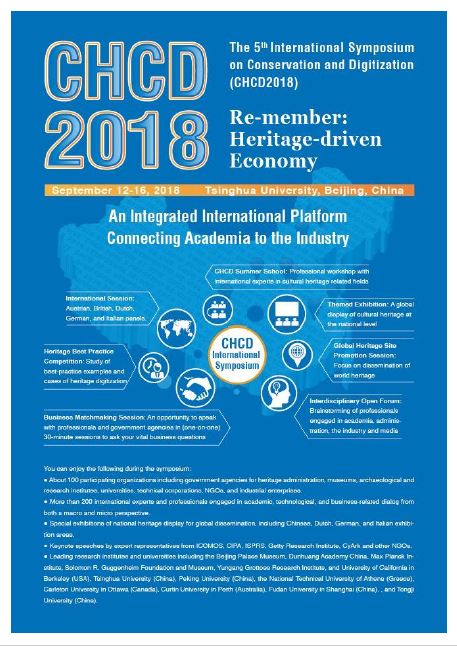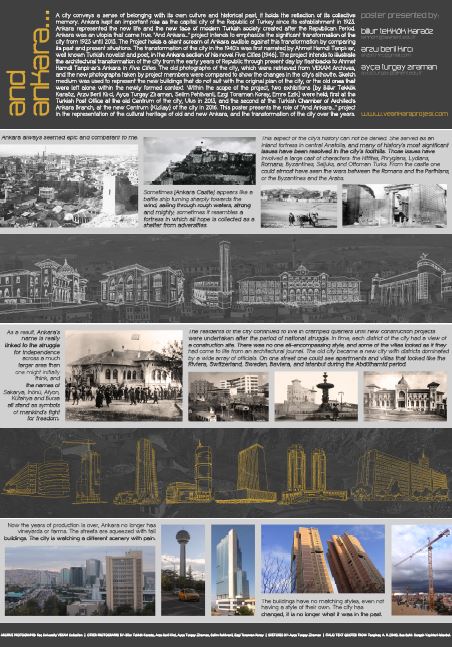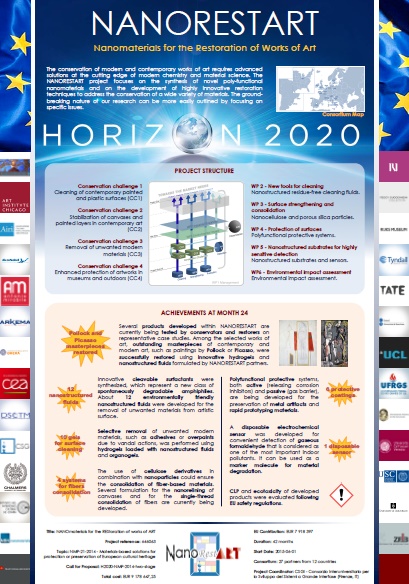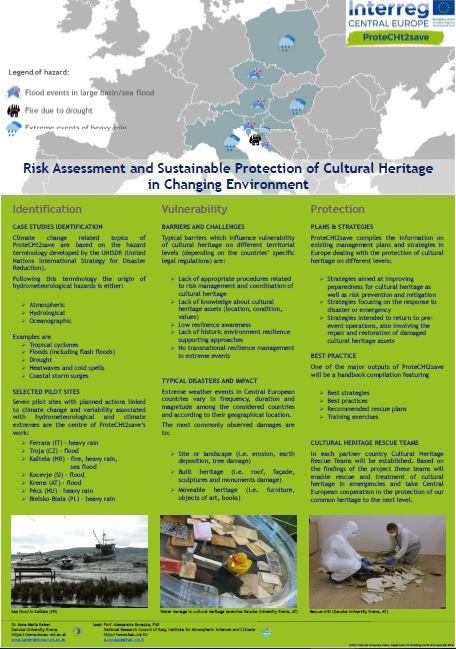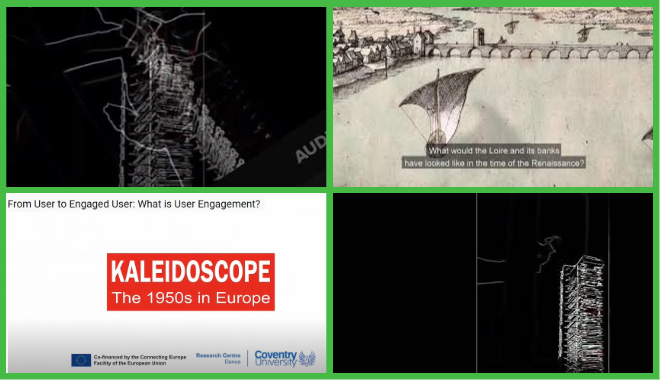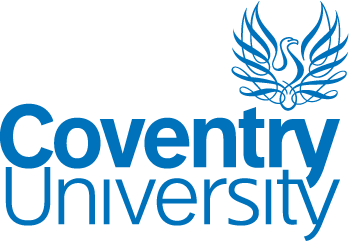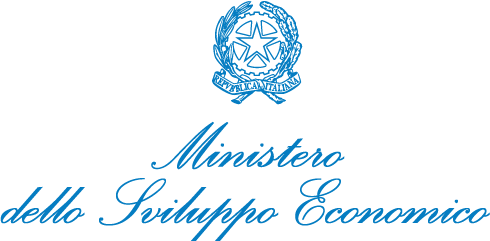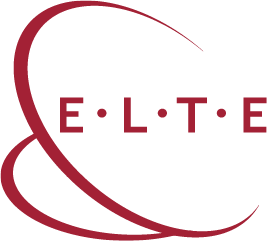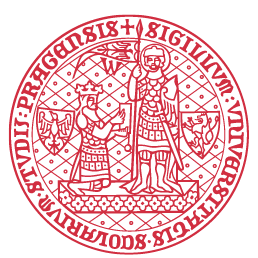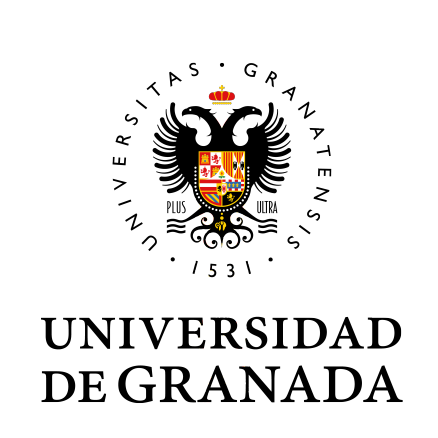| A proposal for the EU Urban Agenda | |
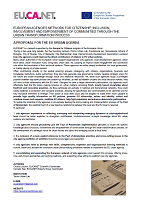 Download the poster | EUCANET is a network supported by the Europe for Citizens programme of the European Union. During a two year long debate, the five founding partners (Torino Urban Lab, Fondazione per l’Innovazione Urbana of Bologna, City of Skopje, City of Marseille, Cluj Metropolitan Area Intercommunity Development Association) explored how City Agencies could improve the direct contribution of citizens to EU urban policies. |
| A visual tool for the display of the visual representations of the Roma of Romania in the 19th and 20th centuries in the Europeana collections: between stereotypes and truthfulness | |
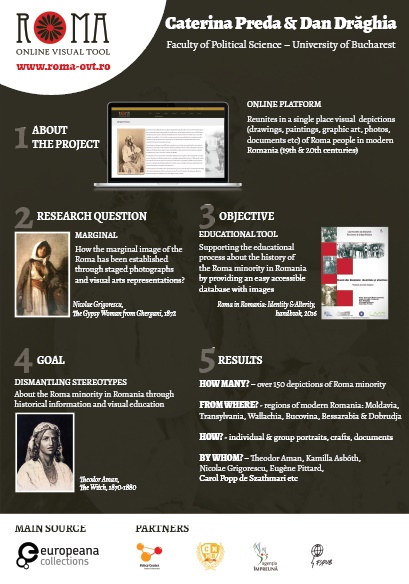 Download the poster | This project displays an online platform, which reunites the visual depictions of the Roma (also called Gypsies) of the current territory of Romania in the photo-archives, and visual arts sources (paintings, drawings, graphic art, film, etc.) of the Europeana collections. We argue that the current discrimination and marginalization of the Roma communities throughout Europe, and in Romania in particular, are based on a long historical process, which proceeds from the slavery of the Roma in Romania up to mid-19th century, and their subsequent assimilation as a marginal community. |
| An Analysis of Attitudes towards Cultural Heritage on Twitter during Nepal Earthquake | |
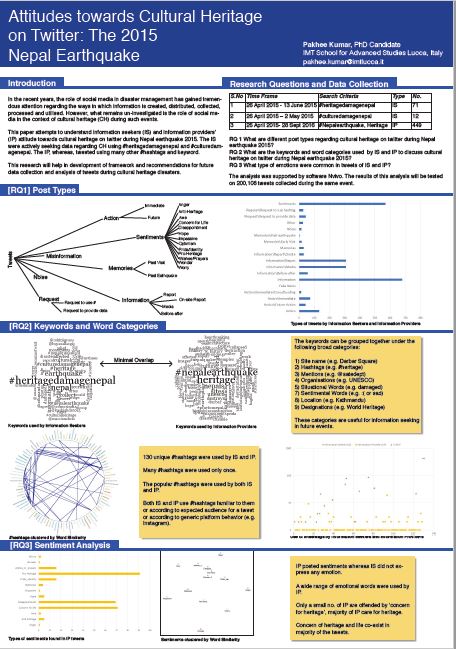 Download the poster | Addressing the gap in research in understanding the use of social media in the context of cultural heritage disasters, the poster attempts to understand information seekers and information providers’ attitude towards cultural heritage on Twitter during Nepal earthquake 2015. The research is done by the content analysis of manually collected 449 tweets using hashtag #Nepalearthquake with keyword heritage. These tweets are compared with 71 tweets collected manually using #heritagedamagenepal and 12 tweets collected manually using #culturedamagenepal. This analysis is the first step in understanding the data, which will be used later to test more data from Nepal earthquake. |
| An Integrated International Platform to Connect the Academia and Industry -The 5th International Symposium on Cultural Heritage Conservation and Digitization (CHCD2018) | |
| The International Symposium on Cultural Heritage Conservation and Digitization (CHDC) is an important international conference in the field of cultural heritage conservation and digitization, co-hosted by the International Committee for Documentation of Cultural Heritage (ICOMOS-CIPA), the Chinese National Committee for the International Council on Monuments and Sites (ICOMOS-China) and Tsinghua University. CHCD is started in 2010 and is held every two years. CHCD2018 is to be held on September 12-16, 2018 at Beijing, China. Under the theme “Re-member: Heritage-driven economy, CHCd2018 will discuss how modernity can decode and interpret cultural heritage and its historical information and value, as well as investigating the role cultural heritage can play as entrepreneurship development model in the contemporary era. |
| Ancient History Encyclopedia | |
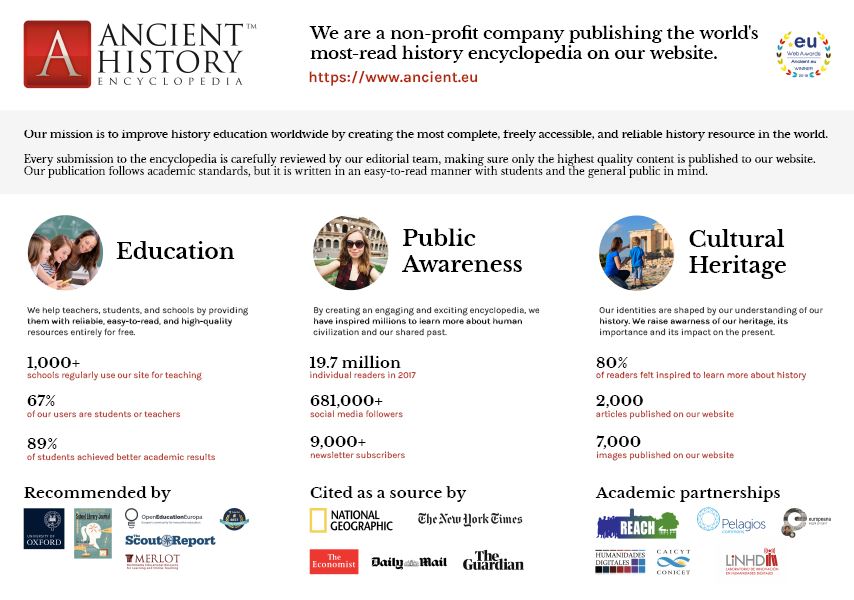 Download the poster | This poster is a short introduction to Ancient History Encyclopedia, the world’s most-read history encyclopedia. It is run by a non-profit company with the goal of getting more people interested in history. The preservation of cultural heritage starts in people’s minds, and getting them to understand how our history relates to the present is the best way to make people care about cultural heritage. |
| And Ankara Project | |
| And Ankara Project intends to emphasize the significant change of the city from 1923’s to 2013. The Project holds a silent scream of Ankara audible against this change by comparing the old and present day Ankara and it intends to illustrate the architectural transformation of the city from the early years of Republic through present day. The etchings of preeminent buildings were placed on old photos were used to illustrate preserved buildings, and newly built skyscrapers that does not match with the original plan of the city. Within the scope of the Project two exhibitions were held in 2013 at the Turkish Post Office at the old Centrum of the city, Ulus and in 2016 at the Turkish Chamber of Architects Ankara Branch, Kızılay; new Centrum of the city.This poster presents And Ankara.. Project ‘s role through the exhibition of the cultural heritage of old and new Ankara, and the transformation of the city over the years. | |
| Architecture of the Abandoned | |
| Bagoly-lyuk (“Owl-hole”), officially Szúcs-Bányatelep, is a prime example of settler housing on a mining landscape. This settlement lies 3 km from the centre of Szúcs, north-west from Eger. By car it is only accessible on a secondary main road or on a forest track. The community and its population is characterised by physical, social and cultural segregation suffering from poor housing conditions, therefore, a number of community-building programmes were launched in 2015. The Autonomia Foundation and the Katona József Theatre have taken on organising theatre pedagogical and community-building programmes. Furthermore, there is a home improvement assistance programme founded with donations. What is still missing is the genius loci created by the community, a place for drama and solutions, a creative and self-creating space: a stage for both the individual and the community. | |
| C-DaRE Conversations | |
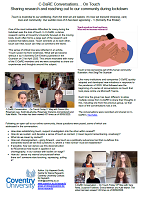 Download the poster | This project began as a response to an article in the Guardian about the loss of touch. The purpose of the Conversations on Touch project was for colleagues in the centre to engage in small group discussions about how the experience of the loss of touch, due to COVID-19 is affecting them and others. To also draw on their expertise in touch-based practices to discuss what this means for dance practice and what might be offered as a remedy to the situation. The focus of the conversations shifted as the experience of the lockdown and the absence of touch changed over time. The conversations were recorded so we could share them with our online community and enable a wider discussion. |
| Commodifying the contested: Institutionalising “difficult” heritage of dictatorships in post-socialist Europe | |
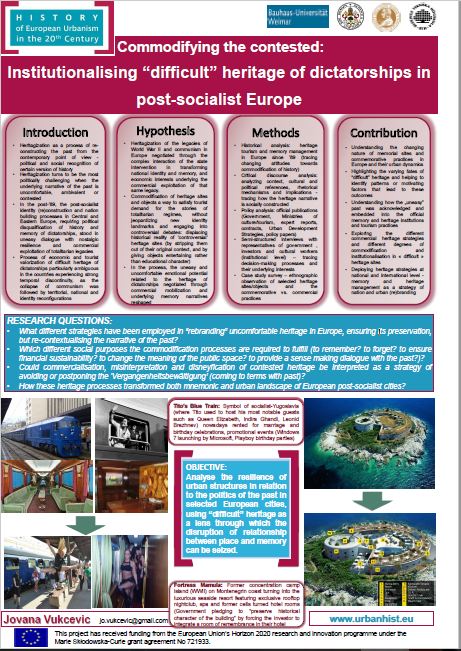 Download the poster Download the poster |
The poster will present part of the on-going research related to the role of uncomfortable heritage in nation branding, specially focusing on specificities of politics of memory, forgetting and revisionism in the post-socialist Europe. It will address the legacies of unwanted, ambivalent or unacknowledged past and different strategies employed by both states and private actors in re-branding their ‘contested’ heritage, ensuring its preservation, but re-contextualizing the narrative of the past through contemporary tourism practices. It questions the interplay between nostalgia, heritage and market, and the role of heritage in polishing the history of totalitarian and authoritarian regimes in the Balkans. |
| Communicating Immersive Architectural Legacies in Virtual Realities | |
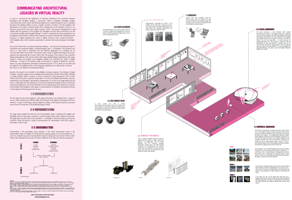 Download the poster | This research investigated how virtual realities alter the experience of the tangible and intangible, and how these environments can still communicate tangible and intangible heritage. The purpose of this research was to develop digital representations of the Gordon Wilson Flats, a building with contested heritage value in Wellington, New Zealand, following a digital heritage methodology. |
| Cultural Heritage as a Source of Societal Well-being in European Regions | |
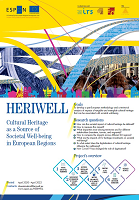 Download the poster |
Heriwell is a project launched by Espon EGTC and carried out by Istituto per la Ricerca Sociale (IRS, Milan) with Associazione ACUME as a sub-contractor; European Association of Cultural Researchers (ERICarts, Bonn and Cologne); Associazione Economia della Cultura (AEC, Rome). The aim is to provide evidence and data on the impact of cultural heritage on societal well-being by developing a pan-European methodology. The first output of the HERIWELL project will be a conceptual framework on the two terms cultural heritage and societal wellbeing. |
| Cultural Heritage as development strategy in social innovation projects |
|
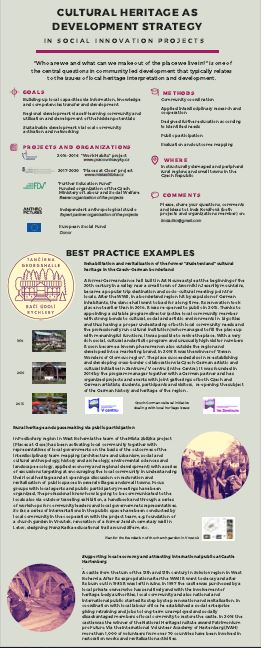 Download the poster |
"Who are we and what can we make out of the place we live in?" is one of the central questions in community led development that typically relates to the issues of local heritage interpretation and development. Goals of the project: building-up local capacities via information, knowledge and competencies transfer and development, regional development via self-learning community and utilisation and development of the hidden potentials, sustainable development via local community activation and networking. |
| Cultural heritage in danger, a resource for the communities | |
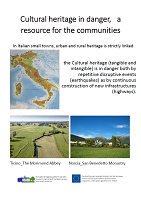 Download the poster | The Ministry of economic development (MiSE), in collaboration with the Department of architecture, built environment and construction engineering (DABC) of Politecnico di Milano has focused its action in helping those communities of Italy whose cultural identity has been put in danger by disruptive events or has experienced a gradual period of downturn due to changes in the social and economic fabric. Actions put in place has targeted at enhancing social cohesion and generating opportunities of renaissance through participatory approaches in the philosophy of the REACH project. |
| DANube Urban Brand | |
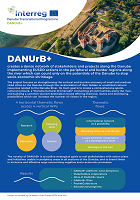 Download the poster | DANUrB has the opportunity to use the potentials of an internationally visible system and turn peripheral situations into advantages by attracting visitors and inhabitants attracted by the Danube but searching for slow life with authentic values. Therefore DANUrB aims a Branding of DANUrB values to increase the attractiveness of towns and regions to offer a network of heritage assets valorized that are authentic in peripheral regions, but are interesting as they are interregionally connected to the Danube. |
| Daring Participation - transforming institution | |
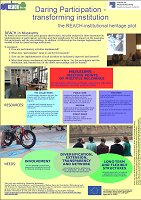 Download the poster | The REACH pilot on institutional heritage analysed the implementation of participatory activities in museums, their significance and impact. Special attention was paid to the complex relationships between institution - audience - society and the (constantly) changing expectations of museums. On this basis, needs for action were derived in order to improve the room for manoeuvre of museums and to enhance their societal relevance and benefits. |
| Developing Sustainability Decisions of an Abandoned Historic Rural Settlement: The Case of Basayas Village | |
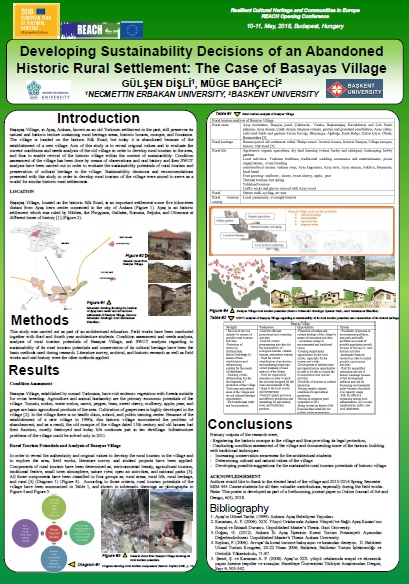 Download the poster | Başayaş Village, in Ayaş, Ankara, known as an old Turkmen settlement in the past, still preserves its natural and historic texture containing rural heritage areas, historic houses, mosque, and fountains. The village is located on the historic Silk Road, but today it is abandoned because of the establishment of a new village. Aim of this study is to reveal original values and to evaluate the current conditions and needs analysis of the old village in order to develop rural tourism in the area, and thus to enable revival of the historic village within the context of sustainability. Condition assessment of the village has been done by means of observations and oral history and then SWOT analysis have been carried out in order to evaluate the sustainability potentials of rural tourism and preservation of cultural heritage in the village. |
| Ductility is the Memory | |
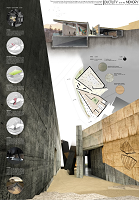 Download the poster | ’’DUCTILITY is in the MEMORY’’ is a motto that wants to enclose the emotional and technological character of the project: high-strength materials used today in construction must be ductile, also the thought of people that have experienced a drama has to be ductile, to process the event since to be able to overcome it; and so, ductile wants to show itself this new place that is going to generate, offering itself to citizenship not only as an earthquake memorial (memory room) but also as reconciliation space as well (green and rest areas), as a place of experience of drama for those who have not lived it (path of the walls), and as a site of rebirth dedicated to young people and knowledge (reading room). |
| ECHOES “Enabling Cultural Heritage Oriented European Strategies" | |
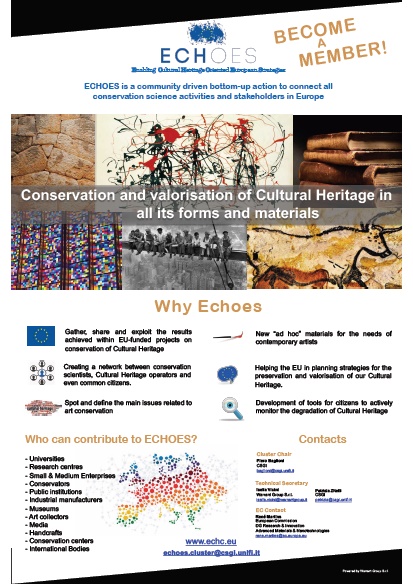 Download the poster | ECHOES is a new European initiative coordinated by CSGI and Warrant Group to connect all conservation science activities and stakeholders in Europe. The cluster is a bottom-up action open to all the people and institutions involved in the Cultural Heritage field to create a community and stimulate discussion between experts with different backgrounds. The network includes the major players from both academia and industrial sectors, policy makers, standard bodies and even common citizens. |
| eHERITAGE project | |
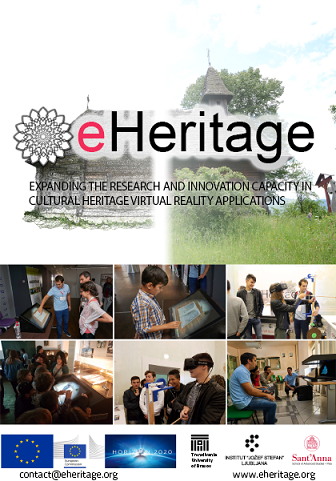 Download the poster | eHERITAGE (‘Expanding the Research and Innovation Capacity in Cultural Heritage Virtual Reality Applications’) is a Coordination and Support project which addresses the “twinning” challenges described in the topic H2020-TWINN-2015 of the Work programme. The general objective of eHERITAGE project is to increase the capacity, quality and extent of the research staff of Transilvania University of Brasov, by establishing strong and sustainable research cooperation schemes with the partners, based on close scientific and social interaction. By creating applications for cultural heritage sites, eHERITAGE contributes to the spread of knowledge in the fields of history and arts, and having a department specialized in these techniques which is based in Romania if the first step in consolidating this research field in the eastern Europe. |
| EKA Estonian Academy of Arts | |
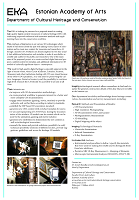 Download the poster | Estonian Academy of Arts, Department of Cultural Heritage and Conservation is looking for partners for a proposal aimed at creating high-quality digital resources of cultural heritage with combining improved traditional and innovative methods and implementing these into the cultural heritage conservation workflow. The emphasis of digitisation is on various technologies which enable to tell stories about the past with adding various layers of information and to create new content for museums and researchers. |
| EUROPEAN HERITAGE TRIBUNE a newsletter on Europe's cultural Heritage | |
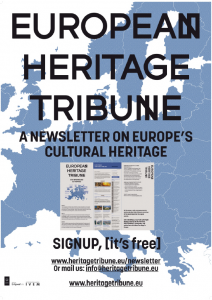 Download the poster | The European Heritage Tribune is an independent digital news platform that offers an overview of the most important news, events, opinions and best practices in the heritage sector from all European Countries. The goal is to strengthen the European network by sharing knowledge, connecting people within cultural and creative sectors across Europe. |
| Forget Heritage – Validated methodology of creative revitalization of abandoned buildings in CE cities | |
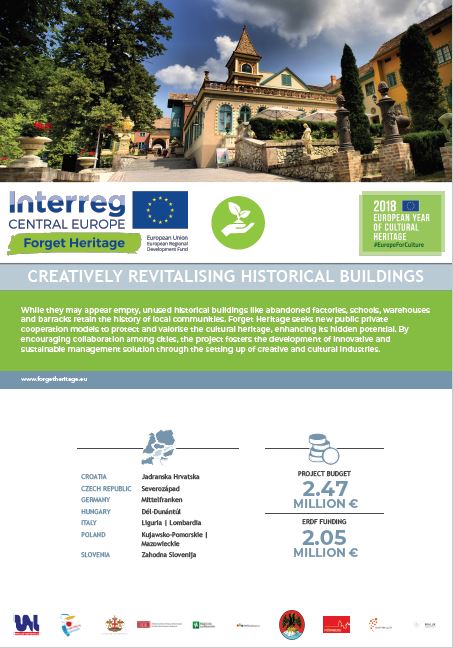 Download the poster |
Forget Heritage will tackle the question of how to improve capacities of the public and private sector or sustainably using cultural heritage and resources in Italy, Slovenia, Germany, Poland, Croatia and Czech Republic. Most cities in these countries are characterised by the presence of unused historical buildings such as former factories, hospitals, schools, barracks that have marked the history of the local community. |
| Former Industrial Water Plant Timisoara open to the public | |
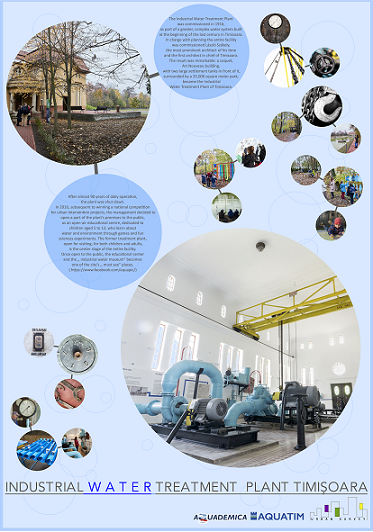 Download the poster |
The project Former Industrial Water Plant Timisoara open to the public integrates into the regional cultural network an industrial facility, commissioned in 1916 and in preservation since 2006. Visiting the plant, with all its equipment kept intact and in place, is a genuine “immersion” in the past. Connecting people with their roots and history, the project reveals the value of the industrial heritage, as part of the cultural identity, and raises awareness on the community’s responsibility for its preservation. For Timisoara, this plant is the first piece of decommissioned local industrial heritage saved from degradation and from falling into oblivion. The project is under evaluation in the 2018 EU Prize for Cultural Heritage (reference number: HA-2018/RO/05). |
| From the memories of our parents to the eyes of our children | |
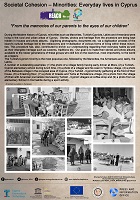 Download the poster | Minority heritage is one of the thematic areas under the scope of REACH project. The society of Cyprus is a jigsaw of small ethnic and religious groups, formed during its turbulent history. Greek-Cypriots consists the major one, however, there are four other communities living in Cyprus today, the Turkish-Cypriots, the Maronites, the Armenians and the Latins. For those people is vital to retain its customs, traditions, everyday habits, conceptions and identity. |
| Good Practices for participatory approaches in culture | |
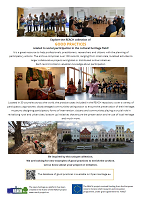 Download the poster | The REACH's good practices collection comprises over 100 cases in 30 countries, covering a variety of participatory approaches in the field of CH, with an emphasis on small-scale, localised examples, but including also larger collaborative projects and global or distributed online initiatives. This collection helps professionals, researchers and citizens with the planning of participatory actions. |
| Heritage of vineyards and wine: a future for the ancient culture in the region of "Condado de Huelva" (Spain) | |
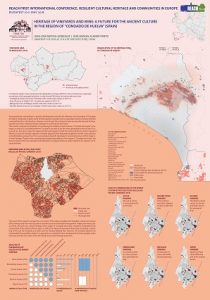 Download the poster | This research analyzes the possibility of considering the traditional vitiviniculture in "Condado de Huelva", southwest of Spain, as well as its associated elements. The goal is not only to set the most appropriate technical way of carrying it out, but also to argue the reasons that should support it, both for society and for the sector in question. The pioneering heritage interpretation of the region of has allowed the identification of a large and diverse system linked to the culture of vineyards and wine. The result of the research has been the concretion the values, tangible and intangible, cultural and natural, of this heritage and which would deserved social and institutional recognition. |
| Hetor: Protection and Preservation of Campania Cultural Heritage | |
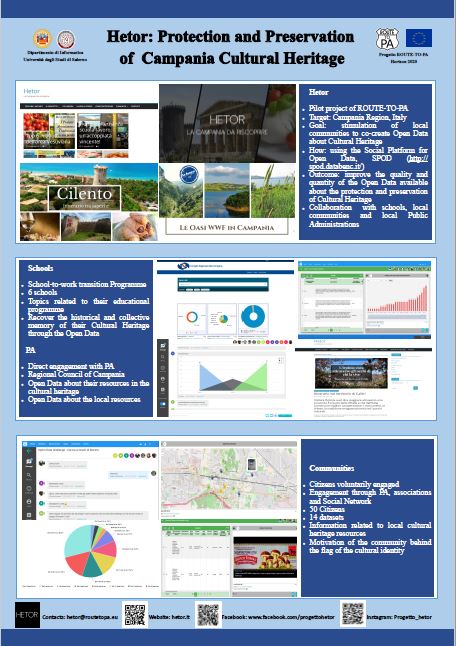 Download the poster |
Hetor is a pilot project of ROUTE-TO-PA. It is devoted to stimulate local communities to co-create Open Data about Cultural Heritage, to improve the quality and quantity of the Open Data available about the protection and preservation of Cultural Heritage and enhancement of local cultural and environmental resources. The project has as a target the Campania Region in Italy. The initiatives involved three communities of the local territory: a community of citizens, a community of local associations' members and a community of students. In this study, we take into consideration the engagement of the local citizenship, which has been reached in particular with the Open Data Challenge experience. The citizens contributed to the creation of public value, in collaboration with the local Public Administration, by discussing topics in the context of the local Cultural Heritage. They generated information both from pre-existing and co-created open datasets, using the SPOD platform. These experiences represent a bottom-up approach that directly involves the citizenship in a series of crowdsourcing activities in the field of the Cultural Heritage, collecting data and disseminating the gained knowledge to the whole community. |
| Is cultural heritage able to provide sustainable community capital? | |
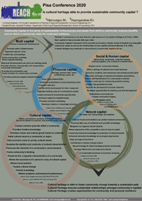 Download the poster |
This poster shows the impact of cultural heritage in various forms of community’s capital and how it is used to offer opportunities for community sustainable development. In the terms of sustainability, the overall goal for cultural heritage, is to create interrelationships between the capitals in order to secure balance, leading towards a path of community resilience through regional competitiveness and community coherence. This research serves the purpose of defining the multilevel impact of heritage, on human as an entity and on group, as community. The sublevel analysis of each capital aims at casting light on various aspects of life as a contribution to humanity’s future. |
| Kaleidoscope: User Engagement Strategies for Digitized Photographic Heritage | |
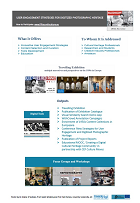 Download the poster | The Kaleidoscope project aimed to enhance user engagement with digital cultural heritage by focusing on archival photographs related to the project theme ‘1950s in Europe’. The user engagement strand of the project was led by Coventry University, who collaborated with consortium partners to conduct research into innovative user engagement strategies. Drawing on participatory arts practice frameworks, four strategies were employed: co- creation, crowdsourcing, rephotography and digital storytelling. |
| Kodra: Culture of peace | |
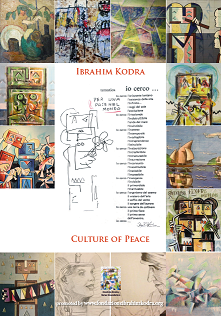 Download the poster |
Iconographical presentation of cultural heritage of European painter Ibrahim Kodra, was born in 1918 in Albania and he started to study in Italy from 1938. His artistical activities brought philosophical message with original identity through poetical and visual creations. After his passing, Ibrahim Kodra Swiss Foundation continues to diffuse his message about importance of peace through cultural and educational activities in Europe and other countries of the world. Some of images are present on the poster like a visual message. For example, educational activities for peace in Kosovo with young artists like cultural bridge of European heritage in the world. |
| Large scale Cultural Heritage Ecosystem to create valorization strategies through a digital approach | |
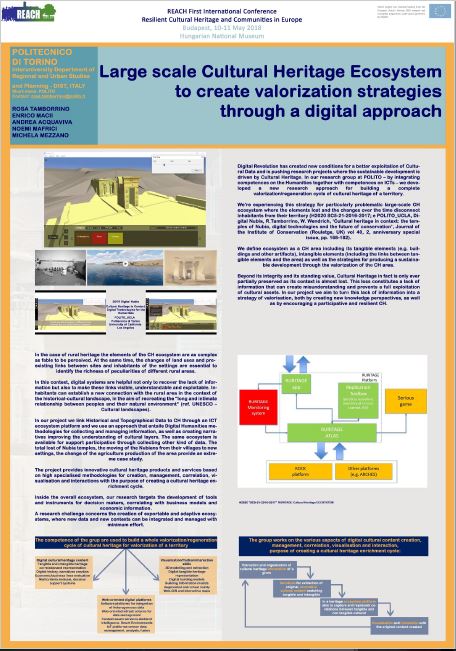 Download the poster |
In our project we link Historical and Topographical Data to CH through an ICT ecosystem platform and we use an approach that entails Digital Humanities methodologies for collecting and managing information, as well as creating narratives improving the understanding of cultural layers. The same ecosystem is available for support participation through collecting other kind of data. The total lost of Nubia temples, the moving of the Nubians from their villages to new settings, the change of the agriculture production of the area provide an extreme case study. |
| My Cultural Heritage.Young residents of small towns about their heritage. | |
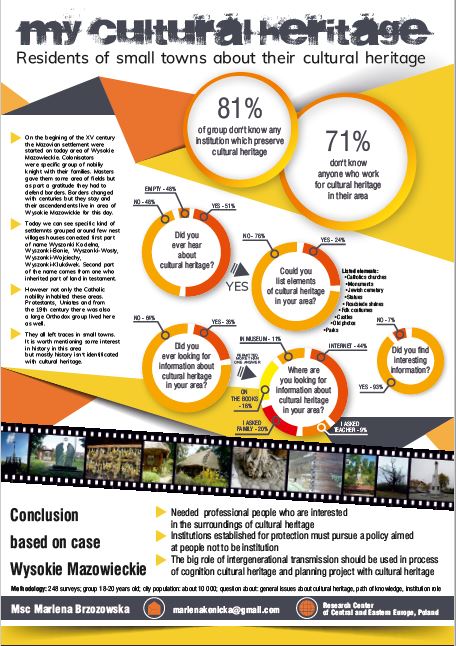 Download the poster Download the poster | Small towns of Mazovian- Podlasie border, between Łomża and Białystok doubtless have multicultural history. In most of them was lived Catolics, Jews, Orthodox and Evangelics. They left traces on landcape and people rememberance. We should to ask people what they know about cultural heritage in places they are living – as a consequence, heritage left for them. Good way for asking is questionnaire adressed to adult, but still young people - high school graduates, study in four small towns schools (about 300 responders), who at least theoretically have unlimited acces to knowledge on the Internet. Where they meet cultural heritage? Where they get knowlage? The answer to these questions will allow to find the right channels to popularize knowledge about cultural heritage in small communities. |
| Monastery in Bzovík - conclusions and recommendations of value assessment and management plan | |
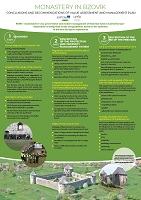 Download the poster | The consortium of researchers from Central Europe actually finished Interreg CE project RUINS Sustainable re-use, preservation and modern management of historical ruins in Central Europe – elaboration of integrated model and guidelines based on the synthesis of the best European experiences. The outputs are based their goal on the finding that cultural heritage represents a great potential for protection, economic growth, and it can generate new values for local communities. |
| Museological resources in small and medium-sized cities in Andalusia | |
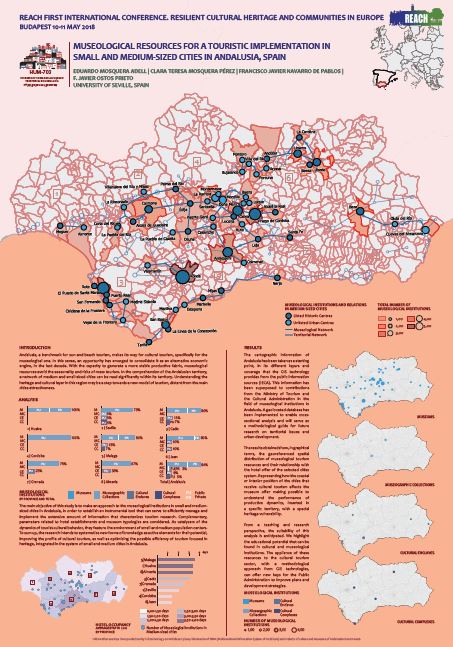 Download the poster | The main objective of this study is to make an approach to the museums in small and medium-sized cities in Andalusia, in order to establish an instrumental tool that can serve to efficiently manage and implement the extensive amount of information that characterizes tourism research. Complementary, parameters related to hotel establishments and museum typologies are considered. As catalyzers of the dynamics of tourist-cultural behavior, they feature the environment of small and medium population centers. To sum up, the research intends to systematize new forms of knowledge as active elements for their potential improving the profile of cultural tourism, as well as optimizing the possible efficiency of tourism focused in heritage, integrated in the system of small and medium cities in Andalusia. |
| NANORESTART - NANOmaterials for the REStoration of works of ART | |
| NANORESTART is an H2020 project coordinated by CSGI - University of Florence and it focuses on the preservation of modern and contemporary works of art. NANORESTART, with a budget of ca. 9 million euros, is an extraordinary example of the effective collaboration between natural and social sciences. The partnership (almost 30 partners) gathers the main research centres (CSGI, Chalmers University, National Research Council, UCL…), and museums (Solomon Guggenheim Collection, TATE Gallery…). | |
| NewPilgrimAge | |
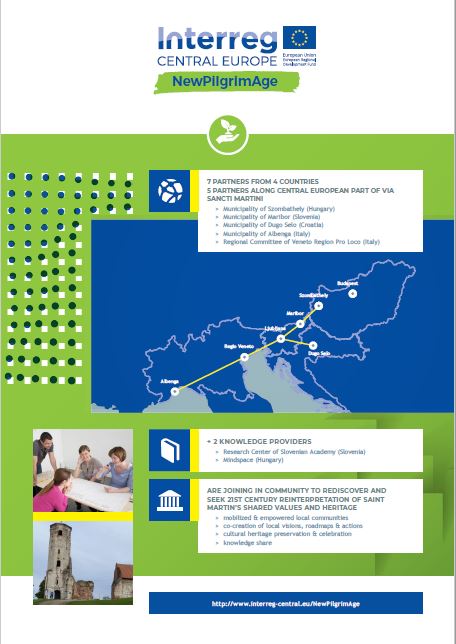 Download the poster |
Saint Martin, the symbol of sharing, is one of the most popular saints in central Europe with thousands of monuments and intangible heritage (folk traditions, legends) keeping his memory alive. Partner cities of the NewPilgrimAge project are located along the European Cultural Route of Via Sancti Martini. They join forces to revive this cultural heritage and promote the common European values of solidarity and hospitality linked to St Martin. Cities and cultural organisations from five countries will mobilise their citizens, most of all young people and small enterprises, to propose and jointly develop new creative initiatives valorising the untapped heritage potentials. |
| open-heritage.eu, the online platform about heritage research | |
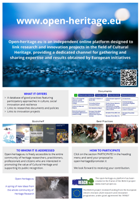 Download the poster | open-heritage.eu is the independent online platform of the REACH project designed to link research andinnovation projects in the field of Cultural Heritage.It is freely accessible to the entire heritage research community and offers different types of resourcesand mechanisms of interaction for sharing knowledge and experiences: a database of Good Practices (participatory approaches in culture, social innovation andresilience);links to research documents and policies;links to innovation projects. |
| Organizing, promoting and enabling heritage re-use through inclusion , technology, access, governance and empowerment. | |
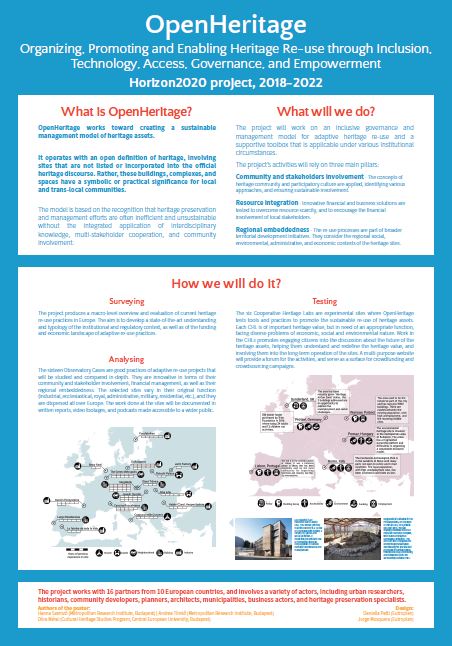 Download the poster | The poster aims to provide an insight into the main focus of OpenHeritage, a new H2020 project – about to begin in June, 2018 – which aims at developing and testing an inclusive governance model and a supporting toolbox for the adaptive reuse of cultural heritage assets. The project builds on the role of communities and the possibility of empowering them in the redevelopment process based on the concepts of heritage community and participatory culture. It operates with an open definition of heritage, not limited to listed assets but also involving those buildings, complexes, and spaces that have a symbolic or practical significance for local or trans-local heritage communities. |
| PAGODE – Europeana China | |
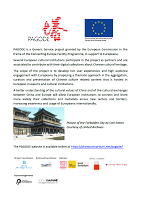 Download the poster |
PAGODE is rooted in the belief that the Europeana experience and the common care for cultural heritage know no borders. The project is designing a semantic framework to speak about Chinese cultural heritage in Europe and to highlight Chinese contents in Europeana. It will bring into the spotlight Chinese objects as part of Europe’s cultural history of trade and exchange, encouraging a different understanding of the binary relationship between East and West. |
| Participatory activities at Museo della Grafica in Pisa | |
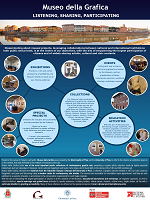 Download the poster | Hosted in the venue of Palazzo Lanfranchi, Museo della Grafica was created by the Municipality of Pisa and the University of Pisa to value a rich collection of prints and drawings and to offer to the citizens an exhibition space in a nice context that adds brilliantly to the network of museums of the city. The poster illustrates briefly the rich programme of engaging initiatives hosted and organised by Museo della Grafica with the aim of empowering the largest participation of citizens and of widely sharing artistic, cultural and civic contents. |
| Participatory Activities on Rural Heritage (Sierra Nevada, Spain) | |
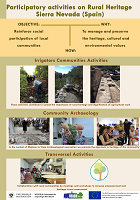 Download the poster | Participatory acitivities on rural heritage carried out in Sierra Nevada (Granada, Spain) has as main objective reinforce social participation of local and rural communities. With this objective we want to manage and preserve rural heritage and enviromental values.The main activities carried out were adressed to Irrigators Communities (cleaness of channel irrigations mainly), with these actions we contribute to spread importance of rural heritage and dignification of agricultural work.Secondly our activities were oriented to Community Archaeology; In the context of Mojácar la Vieja Archaeological excavation we promote the approach to heritage of the community.Finally several Transversal Activities were carried out during our participation on REACH Project. Collaboration with rural communities by meetings and workshops to increase empowerment and heritage issues assessment |
| Pluggy | |
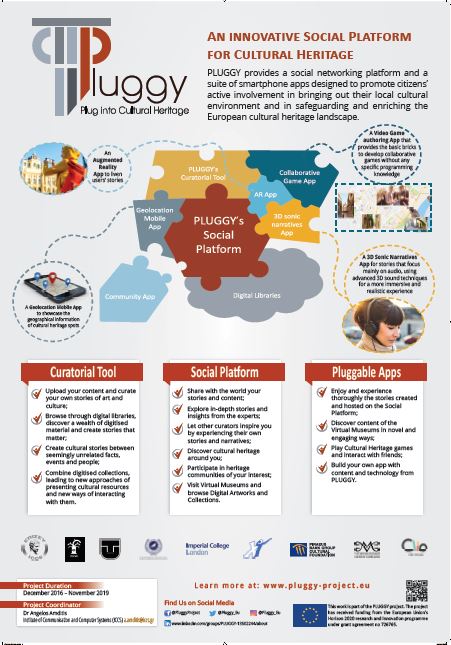 Download the poster | One of the preconditions for genuine sustainability is a heritage that is present anywhere and anytime in everyday life. We present PLUGGY, the Pluggable Social Platform for Heritage Awareness and Participation, an EU funded research project that aims to develop an innovative social platform and a suite of smartphone tools that will enable individuals, community groups, industry, museums and countries as a whole to bring out, document and share their heritage online and thereby celebrate Europe’s collective heritage. Over the next two years, PLUGGY is expected to launch an inventive, Facebook-like social platform as well as a suite of Augmented Reality, Geolocation, 3D Sonic and Gaming smartphone apps that will enable citizens across Europe and the world to shape and pass on both individual and collective cultural experiences, thereby enhancing the value of cultural heritage and contributing towards its enrichment. Through PLUGGY’s social platform and by using its innovative curation tools, designed to solely focus on a niche area in social media, citizens will be able to act as skilled “storytellers” by creating fascinating personalised stories and sharing them through social networking with friends, associates and professionals. |
| PhD Thesis on Digital Heritage | |
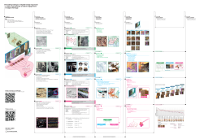 Download the poster |
The poster is a foldout map of a thesis about the use of digital design techniques to steer and diversify creative engagement in digital heritage. It introduces an original study dealing with important gaps in research relating to exploring new roles of public engagement in digital heritage and the production of heritage knowledge that are ‘generative,’ ‘active’ and ‘creative’, rather than consumptive, passive, guided and descriptive. The study is focused on the use of immersive reality technology and gamification concepts in the field of participatory design with an aim to contribute to the invention of novel means for interactivity and creativity in heritage. |
| ProteCHt2save – Risk assessment and sustainable protection of Cultural Heritage in changing environment | |
| The poster will focus on Interreg Central Europe Project ProteCHt2save’s main goal, the improvement of capacities of the public and private sectors to mitigate the impacts of climate change and natural hazards on cultural heritage sites, structures and artefacts, as the project focuses primarily on the development of feasible and tailored solutions for building resilience of cultural heritage to floods and events of heavy rain. First intermediary results of the project are ready to be presented by the poster and will focus on the state of the art of existing archives, maps, databases, and model outputs for risk evaluation concerning climate change related data. | |
| Reaching the Public: Virtual and Real Visitors to a Museum Exhibition | |
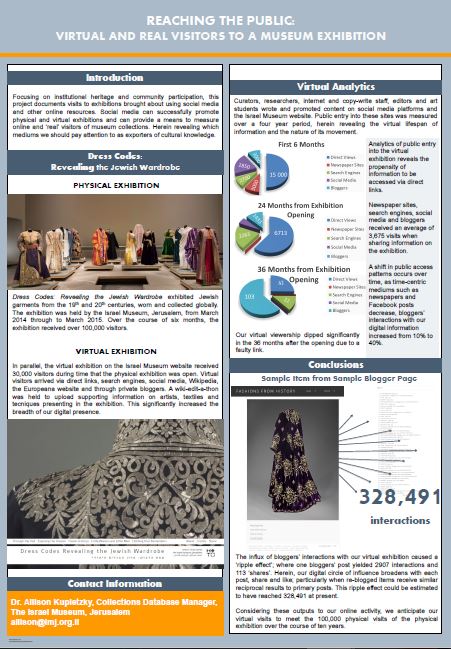 Download the poster | Focusing on institutional heritage and community participation, this project documents the visits to exhibitions brought about using social media other online resources. The real life exhibition “Dress Codes: Revealing the Jewish Wardrobe” was exhibited in the Israel Museum in Jerusalem in 2014 – 2015 and received over 100,000 visitors. In parallel, the virtual exhibition was placed online and received 30,000 visitors over the same length of time. The virtual visitors arrived via direct links, google, Facebook, Europeana, Wikipedia, Tumblr, Pinterest, YouTube, and private bloggers. A wiki-edit-a-thon was hosted during this period of time. Curators, researchers, internet and copywrite staff, editors and art students, were all involved both in promoting and writing in these social media platforms. The results of these activities and how they effected the influx of virtual visitors will be discussed in this poster. |
| Resilient Roma Heritage | |
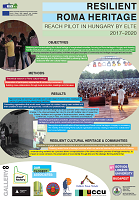 Download the poster | The REACH Minority heritage pilot aimed at analyzing and contextualizing the cultural heritage of marginalized minorities, mostly focusing on Roma heritage in Hungary and the neighboring countries. The pilot also stressed on showing how the institutionalization of (re)appropriated cultural heritage can result in the economic and social revival of socially and culturally deprived (and often oppressed) communities. The work focused on collecting examples of participatory activities and good examples of community-led heritage management in rural and in urban contexts. |
| Roadmap of CIVIC EPISTEMOLOGIES | |
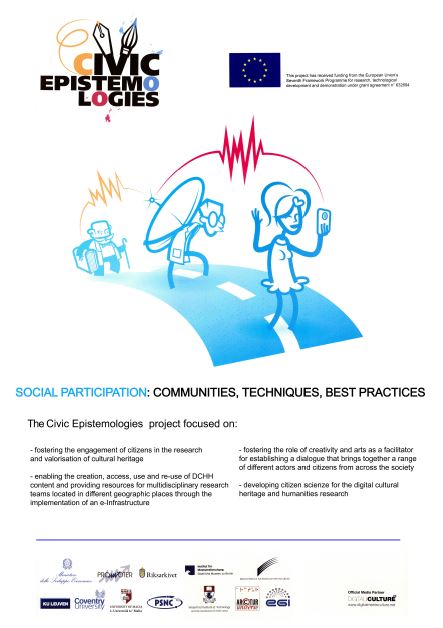 Download the poster Download the poster | CIVIC EPISTEMOLOGIES is a previous EU project about the participation of citizens in research on digital Cultural Heritage and humanities and its main outcome is this Roadmap. |
| ROCK - Cultural heritage leading urban futures | |
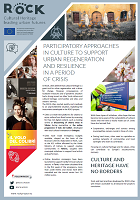 Download the poster |
In ROCK, cities believe that cultural heritage is a great tool for urban regeneration and a driver for change. But consequences of lockdown measures and of pandemic situation had a strong impact on cities’ local culture and cultural heritage, communities and sites, and citizens’ services. The ROCK cities reacted quickly and creatively to an unprecedented situation, exploiting the instruments developed in the ROCK project. |
| RUINS: Sustainable re-use, preservation and modern management of historical ruins in Central Europe | |
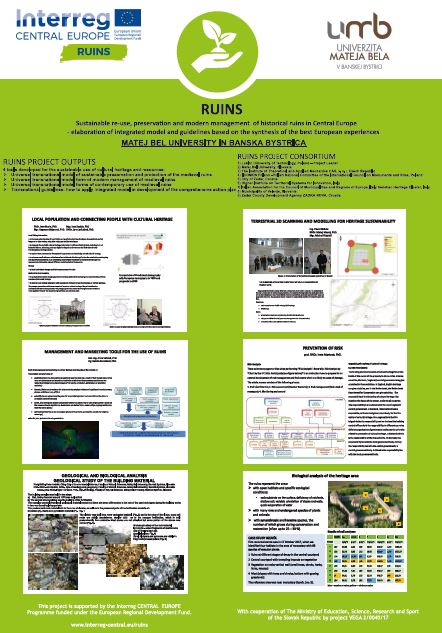 Download the poster | Topic of project are medieval ruins. In Europe there are at least several thousand historical ruins. Owners and managers of these sites struggle with the same problems: protection of ruins is problematic due to ongoing process of destruction, and modern use of ruins is limited. Ruined historical buildings are often either neglected or increasingly transformed. They lose their key features – authenticity and integrity. Problem applies to entire Europe. |
| Rural heritage and creative female entrepreneurs | |
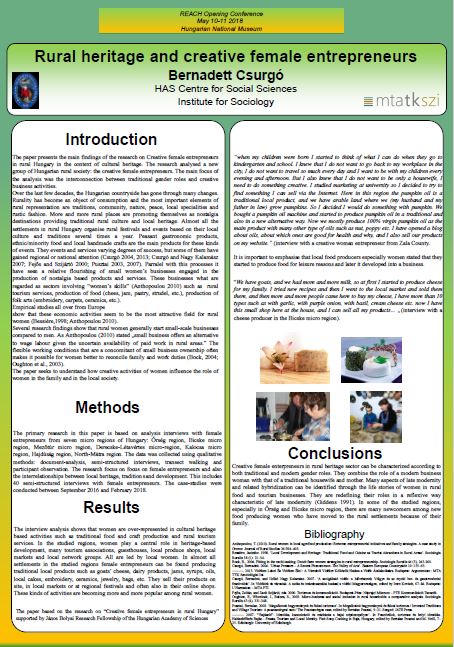 Download the poster |
The poster presents the main findings of the research on Creative female entrepreneurs in rural Hungary in the context of cultural heritage. The analysis shows that women are over-represented in cultural heritage based activities and initiatives. The case studies from seven rural regions from Hungary prove that women play a central role in heritage-based development, many tourism associations, guesthouses, local produce shops, local markets and local network groups. All are led by local women and many of the creative enterprises run by rural women are based on local heritage. |
| SARGENTIA- 3D reconstruction of the capital Ulpia Traiana Sarmizegetusa | |
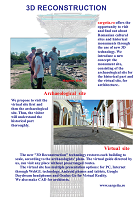 Download the poster |
www.sargetia.ro offers the opportunity to visit and find out about Romanian cultural sites and historical monuments through the use of new 3D technology. We introduce a new concept: the monument site, consisting of the archaeological site for the historical part and the virtual site, for architecture. We propose to visit the virtual site first and then the archaeological site. Thus, the visitor will understand the historical part thoroughly. The new "3D Reconstruction" technology restores each building to scale, according to the archaeologists' plans. The virtual guide directed by us, can visit any place without prearranged routes. Visit www.sargetia.ro . |
| Small Towns‘ Heritage REACH Pilot | |
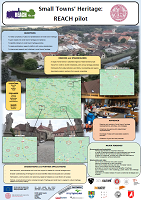 Download the poster |
The Small Towns‘ Heritage REACH Pilot focused on the challenges and perspectives of small towns from the perspective of local cultural heritage. It mapped how cultural heritage has been defined, represented and used. The pilot focused on the Vysočina region in the Czech Republic, with further examples drawn from Poland and Slovakia. The analysis of the common patterns and the diversity in how heritage is used as an asset helped to draw suggestions and implications that may be further used in local cultural heritage management and day-to.day praxis of both institutions and communities in small towns. |
| SoPHIA - Social Platform for Holistic Impact Heritage Assessment | |
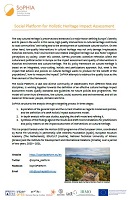 Download the poster |
SoPHIA aims to promote collective reflection within the cultural and political sector in Europe on the impact assessment and quality of interventions in European historical environment and cultural heritage at urban level. |
| The fate of East Prussian Heimatmuseen and the memory of the Masurians in the years 1945-2017 | |
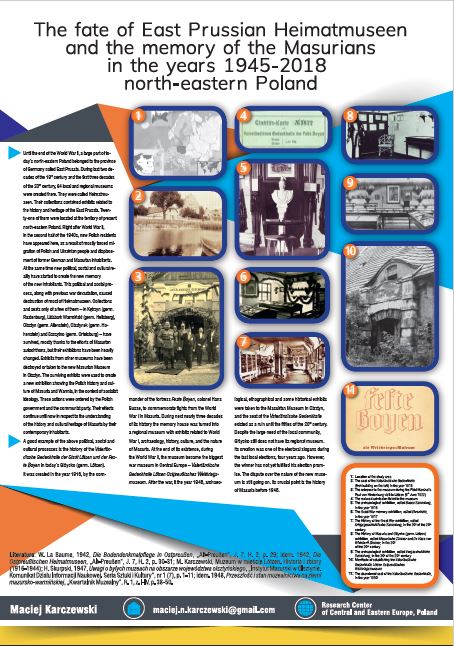 Download the poster | Until the end of the World War II, a large part of today north-eastern Poland belonged to the province of Germany called East Prussia. During the first three decades of the 20th century, several local and regional museums were created there. They were called Heimatmuseen. Their collections contained exhibits related to the history and heritage of the East Prussia. Right after World War II, in the second half of the 1940s, new Polish residents have appeared here, as a result of mostly forced migration of Polish and Ukrainian people and displacement of former German and Masurian inhabitants. At the same time new political, social and cultural reality have started to create the new memory of the new inhabitants. This political and social process, along with previous war devastation, caused destruction of most of Heimatmuseen. Only few of them have survived thanks to the efforts of Mazurian autochthons, but their exhibitions have been heavily changed. Exhibits from other museums have been taken to the new Masirian Museum in Olsztyn or destroyed. The surviving exhibits were used to create a new exhibition showing the Polish history of Masuria. These actions were ordered by the Polish government and the communist party |
| THE HeLLo PROJECT, Heritage energy Living Lab onsite: Ongoing work and Dissemination strategy | |
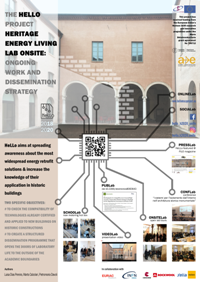 Download the poster | The HeLLo project has two specific objectives: to check the compatibility of thermal insulation technologies on historic constructions and, to create a structured dissemination programme that opens the doors of laboratory life to the outside of the academic boundaries. Herein, part of the work that has been developed so far is shown, through its various dissemination labs. DOI: 10.5281/zenodo.3929533. |
| The Medina of Tunis facing the modern city. Tangible, intangible and social values in an Arabic old city | |
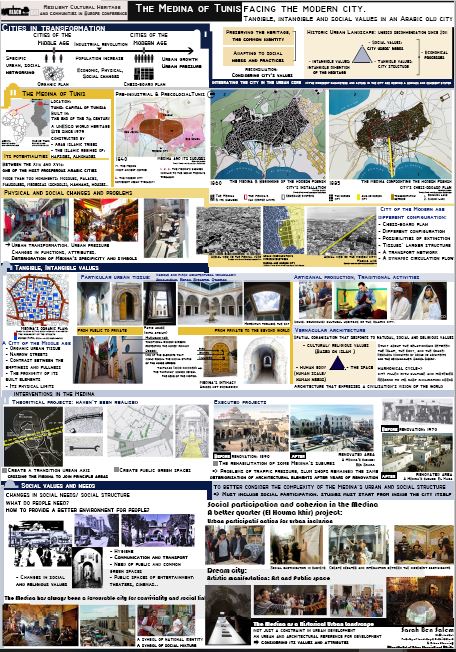 Download the Poster | The objective of the poster is to present the rehabilitation project of the Medina of Tunis, which was designated by UNESCO as a World Heritage Site in 1979. We will analyse the interaction between the tangible and intangible values in the city, from the one side, and the social needs and practices, from the other side. We will evaluate if the social implication and participation are taken into consideration in the main urban projects and interventions in the Medina. As a conclusion, we will suggest a reflexion of how to consider the different tangibles and intangibles parameters of the city and involving the social groups to preserve the city’s identity and respond to its users’ needs. |
| The Right for Education of Roma community in Albania. Building a dialogue between the Roma community and Albanian government | |
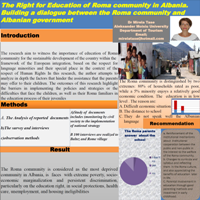 Download the poster |
This poster is a short introduction and explain the importance of education of Roma community for the sustainable development of Albania within the framework of the European integration. Poverty and living conditions also affect the Roma children’s opportunities for education. Often living on the outskirts of town with poor road infrastructure and weak links to public transportation, Roma parents do not have the means to pay for their children’s transportation, textbooks and other school material. In the school curricula, Roma children`s are portrayed as vulnerable groups rather than distinguished identities, which leads to further stigmatization and discriminatory attitudes. Quality education consists of not only classroom-based activities but also community exchange, awareness raising and other activities promoting mutual understanding and inter-cultural dialogue. |
| TRACES | |
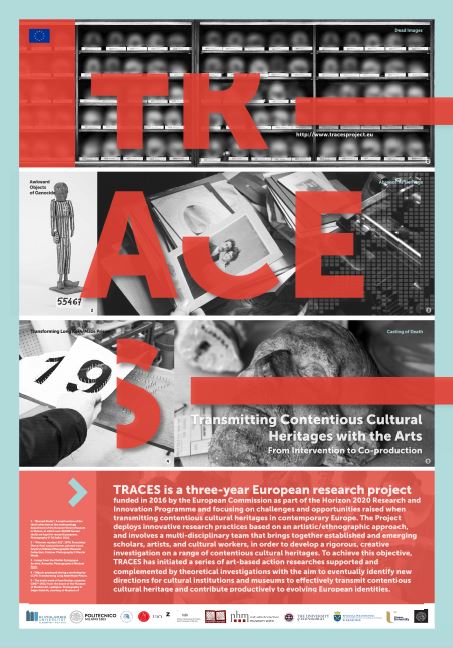 Download the poster | TRACES is a three-year project funded in 2016 by the European Commission as part of the Horizon 2020 Research and Innovation Programme. TRACES investigates the challenges and opportunities raised when transmitting complex pasts and the role of difficult heritage in contemporary Europe. Transmitted sensitively, these heritages can contribute to a process of reflexive Europeanisation that is shaped by on-going critical reflection, and dialogue across different positions. In order to achieve these objectives, TRACES has initiated a series of “Creative Co-Productions” in which artists, researchers, heritage agencies, and stakeholders research together on selected cases of contentious heritage to develop new participatory public interfaces. They are supported and complemented through several investigations pertaining to different research fields and disciplines with the aim to identify new directions for cultural institutions and museums. |
| UNCHARTED - Understanding, Capturing and Fostering the Societal Value of Culture | |
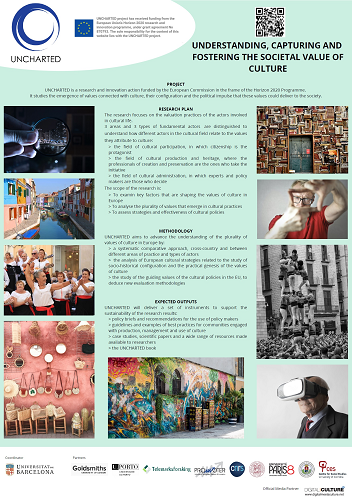 Download the poster |
What is the social value of culture? While culture is increasingly being viewed from an economic perspective, there is much more at stake. Focusing on the valuation practices developed by different actors involved in the cultural sector, the EU-funded UNCHARTED project will identify Europe’s plurality of cultural values attached to specific cultural products, productions, services, activities and sites. It will consider the multiplicity of agents and the diversity of evaluation practices. Led by the University of Barcelona and involving 10 research partners based in France, Hungary, Italy, Norway, Portugal, Spain and the United Kingdom, the project will focus on the valuation practices of the various actors involved in cultural life, from the audience and visitors to the artists to experts and politicians. |
| Urban and rural heritage role in Italian small towns affected by incoming threat and traumatic event - Abbiategrasso in Ticino Park (north Italy) | |
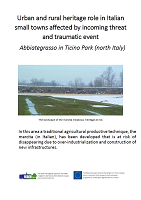 Download the poster | The MISE/DABC main goal is to preserve this tangible cultural heritage of this area of Italy. This heritage is part of the identity of the local communities and also constitutes a set of effective agricultural and handcraft production techniques both in terms of production of food with beneficial properties and natural resources management. It also constitutes a tradition to be handed down from one generation to the other, also in terms of transmission of working skills. The preservation of these cultural identities has positive implications in different settings such as sustainable development, protection of biodiversity and environment, health, quality of life and welfare. |
| |||
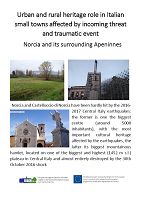 Download the poster | This community is a network of small towns in Central Italy (in the area of Norcia and its surrounding Apeninnes) hit by the 2016-2017 earthquakes. The goal is to help restoring and maintaining the rich cultural identity and values connected to tangible and intangible culture, namely the varied local handcraft activities and rural manufacturing processes that connote this area. The agricultural biodiversity (with the production of typical vegetables, legumes, cheese, cold cuts, etc.) of the territory is due to the particular geomorphology and to the attachment of the local communities to their traditions, habits, way of life and traditional economies. | ||
| Urban heritage characterization of small and medium-sized historic cities in Andalusia (Spain) | |
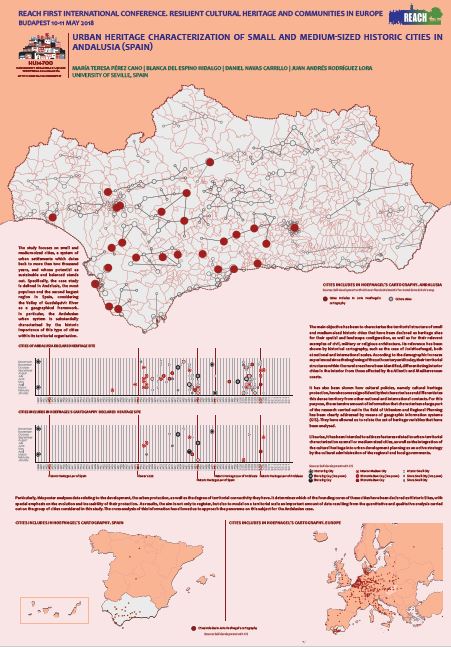 Download the poster | The main objective of this study is to make an approach to the museums in small and medium-sized cities in Andalusia, in order to establish an instrumental tool that can serve to efficiently manage and implement the extensive amount of information that characterizes tourism research. Complementary, parameters related to hotel establishments and museum typologies are considered. As catalyzers of the dynamics of tourist-cultural behavior, they feature the environment of small and medium population centers. To sum up, the research intends to systematize new forms of knowledge as active elements for their potential improving the profile of cultural tourism, as well as optimizing the possible efficiency of tourism focused in heritage, integrated in the system of small and medium cities in Andalusia. |
| |||
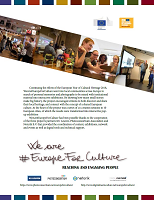 Download the poster | Ten co-creation events across Europe in 2019 engaged citizens of different ages and backgrounds, to realize pop-up exhibitions including both local cultural heritage and crowdsourced heritage. A final event and carousel exhibition at the House of European History in Brussels in February 2020 marked the happy conclusion of a very brilliant project. The project was coordinated by KU Leuven with participation of Noterik and Photoconsortium association. Discover the project and its stories: https://www.photoconsortium.net/europeforculture/ | ||
| We and they. The conflict about heritage in small towns in Podlachia (Poland ) | |
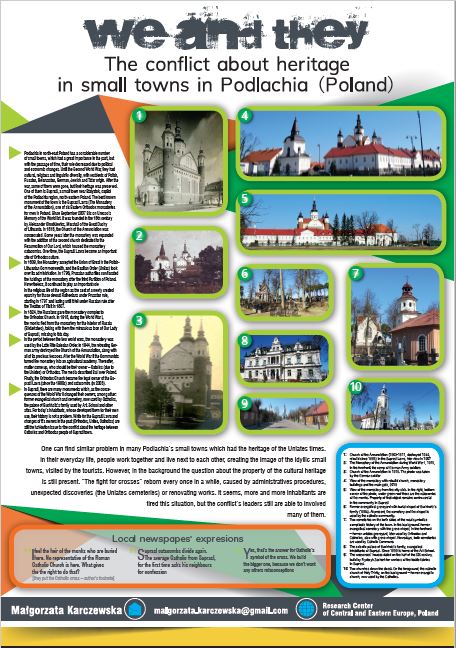 Download the poster | The poster will present several questions about the cultural heritage of small towns in north-eastern Poland, such as Supraśl or Tykocin. Until the Second World War, these towns had cultural, religious and linguistic diversity, with residents of Polish, Russian, Belarussian, German, Jewish and Tatar origin. After the war, some of them were gone, but their heritage was preserved. The depositaries of it are modern inhabitants of these cities, first of all Roman Catholic and Orthodox. What is their attitude to the abandoned heritage of other nations and religions? Are there any problems with cultural legacy of the groups that continue to live in these cities? Are there inflammatory points that have a genesis in the past, which lack of solutions translates into modern conflicts? |

